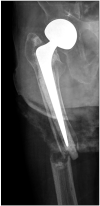Does the Periprosthetic Fracture Pattern Depend on the Stem Fixation Method in Total Hip Arthroplasty?
- PMID: 36778997
- PMCID: PMC9880517
- DOI: 10.4055/cios22004
Does the Periprosthetic Fracture Pattern Depend on the Stem Fixation Method in Total Hip Arthroplasty?
Abstract
Background: Management of periprosthetic femoral fractures (PFFs) is reportedly challenging. Different patterns of PFFs would occur based on whether stem fixation was primarily cemented or cementless and whether these patterns would be associated with clinical outcomes, such as subsidence, fracture union, and complications, after stem revision.
Methods: A retrospective comparative study was performed, involving 52 PFF patients treated with tapered fluted modular stems (TFMSs). In the 52 patients with Vancouver B2 or B3, including 21 cemented stems and 31 cementless stems, fracture patterns and bone stock were analyzed. Clinical outcomes after revision surgery using the TFMSs were compared between the two groups.
Results: Transverse or short oblique type PFFs occurred around the cemented stem with loosening at the bone-cement interface. The Paprosky type III femoral deficiency and Vancouver type B3 fracture were observed more frequently in the cemented stem group. Otherwise, spiral fractures occurred more frequently in the cementless group (p < 0.001). Excessive subsidence of > 5 mm was observed more frequently in the cemented stem group (p < 0.001). The re-revision rates were higher in the cemented group than in the cementless group (p = 0.047).
Conclusions: In our study, it was found that the patterns of transverse or oblique PFFs were more frequently produced with cemented stems, while long spiral fractures were more frequent with cementless stems. Stem subsidence and reoperation related to complications were more common in patients with PFFs around cemented stems than those with PFFs around cementless stems.
Keywords: Periprosthetic femoral fracture; Revision total hip arthoroplasty; Taper fluted modular stem.
Copyright © 2023 by The Korean Orthopaedic Association.
Conflict of interest statement
CONFLICT of INTEREST: No potential conflict of interest relevant to this article was reported.
Figures


Similar articles
-
Cemented vs cementless stems for revision arthroplasties due to Vancouver B2 periprosthetic hip fracture.Eur J Orthop Surg Traumatol. 2024 Jul;34(5):2573-2580. doi: 10.1007/s00590-024-03961-3. Epub 2024 May 2. Eur J Orthop Surg Traumatol. 2024. PMID: 38695885
-
Does Stem Design Affect the Incidence of Periprosthetic Femoral Fractures in Arthroplasty for Femoral Neck Fractures? A Secondary Analysis of the HEALTH Trial.J Arthroplasty. 2025 Aug;40(8S1):S322-S327.e3. doi: 10.1016/j.arth.2025.02.036. Epub 2025 Feb 18. J Arthroplasty. 2025. PMID: 39978649 Clinical Trial.
-
Radiographic and Clinical Outcomes of Modular Tapered Fluted Stems for Femoral Revision for Paprosky III and IV Femoral Defects or Vancouver B2 and B3 Femoral Fractures.J Arthroplasty. 2020 Apr;35(4):1069-1073. doi: 10.1016/j.arth.2019.11.039. Epub 2019 Nov 30. J Arthroplasty. 2020. PMID: 31870582
-
Vancouver B2 Periprosthetic femoral fractures around cemented polished taper-slip stems - how should we treat these? A systematic scoping review and algorithm for management.Orthop Traumatol Surg Res. 2025 Sep;111(5):104110. doi: 10.1016/j.otsr.2024.104110. Epub 2024 Dec 13. Orthop Traumatol Surg Res. 2025. PMID: 39675558 Review.
-
Fracture fixation versus revision arthroplasty in Vancouver type B2 and B3 periprosthetic femoral fractures: a systematic review.Arch Orthop Trauma Surg. 2020 Oct;140(10):1381-1394. doi: 10.1007/s00402-020-03332-7. Epub 2020 Feb 21. Arch Orthop Trauma Surg. 2020. PMID: 32086558 Free PMC article.
Cited by
-
Ipsilateral pubic ramus fracture during total hip arthroplasty is not rare: does it matter?Arch Orthop Trauma Surg. 2024 Jun;144(6):2849-2857. doi: 10.1007/s00402-024-05368-5. Epub 2024 May 14. Arch Orthop Trauma Surg. 2024. PMID: 38743113 Free PMC article.
-
Digital Templating of Hip Arthroplasty Using Microsoft PowerPoint: A Pilot Study with Technical Details.Bioengineering (Basel). 2024 Mar 28;11(4):327. doi: 10.3390/bioengineering11040327. Bioengineering (Basel). 2024. PMID: 38671749 Free PMC article.
-
Femoral stem taper geometry and porous coating in cementless direct anterior primary total hip arthroplasty.J Orthop. 2023 Nov 4;46:169-173. doi: 10.1016/j.jor.2023.11.009. eCollection 2023 Dec. J Orthop. 2023. PMID: 38031626 Free PMC article.
-
Fixation versus revision arthroplasty for Unified Classification System type B periprosthetic fractures around cemented polished tapered femoral components : a systematic review and meta-analysis.Bone Jt Open. 2025 Aug 19;6(8):944-953. doi: 10.1302/2633-1462.68.BJO-2025-0123. Bone Jt Open. 2025. PMID: 40827095 Free PMC article.
References
-
- Duncan CP, Masri BA. Fractures of the femur after hip replacement. Instr Course Lect. 1995;44:293–304. - PubMed
-
- Sidler-Maier CC, Waddell JP. Incidence and predisposing factors of periprosthetic proximal femoral fractures: a literature review. Int Orthop. 2015;39(9):1673–1682. - PubMed
-
- Lindahl H, Malchau H, Herberts P, Garellick G. Periprosthetic femoral fractures classification and demographics of 1049 periprosthetic femoral fractures from the Swedish National Hip Arthroplasty Register. J Arthroplasty. 2005;20(7):857–865. - PubMed
-
- Fitzgerald RH, Jr, Brindley GW, Kavanagh BF. The uncemented total hip arthroplasty: intraoperative femoral fractures. Clin Orthop Relat Res. 1988;(235):61–66. - PubMed
-
- Culp RW, Schmidt RG, Hanks G, Mak A, Esterhai JL, Jr, Heppenstall RB. Supracondylar fracture of the femur following prosthetic knee arthroplasty. Clin Orthop Relat Res. 1987;(222):212–222. - PubMed
MeSH terms
LinkOut - more resources
Full Text Sources
Medical

